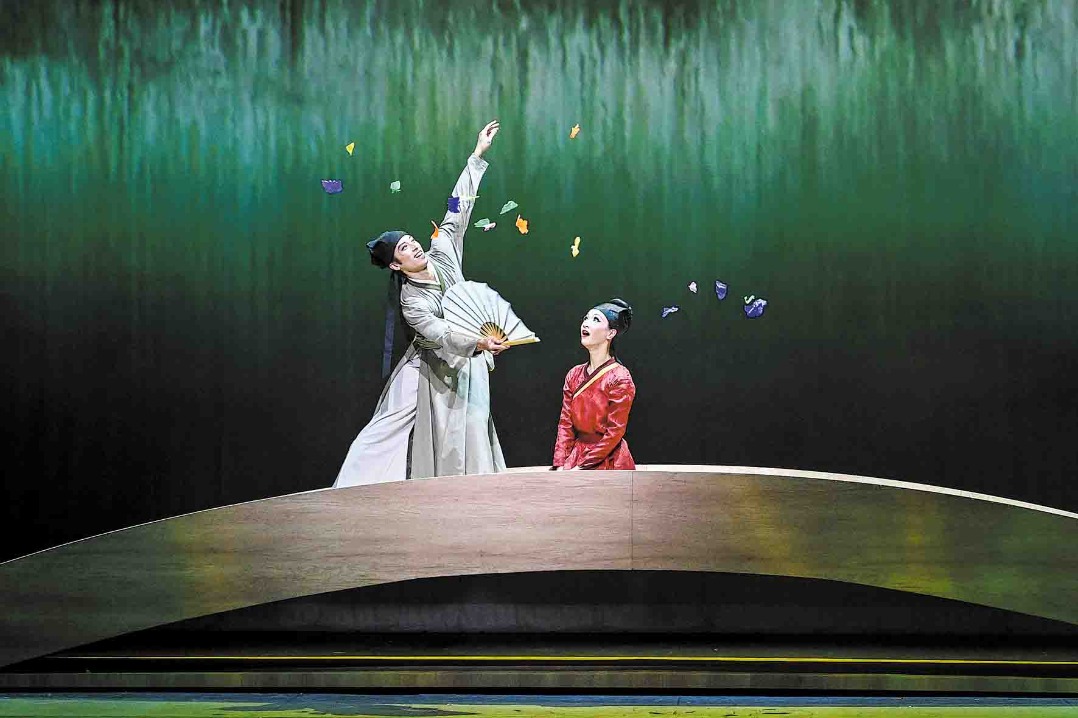Dream collection on show
An exhibition examining the cultural legacy of Cao Xueqin's literary masterwork Dream of the Red Chamber is now available at the National Museum of China website, Lin Qi reports.

Adaptations of works of intellectual property, such as online literature, that have been made into movies and drama series, are sweeping Chinese mass media and proving lucrative.
Yet creating successful IP products is not the monopoly of modern artists. More than 250 years ago, in suburban Beijing, a man named Cao Xueqin made one such work which has endured for centuries-despite never having benefited from its success.
Cao, who was plagued by destitution and illness, authored a semi-autobiographical novel titled Dream of the Red Chamber. In the work he drew on the rise and fall of his own once well-connected family to describe the tragedy of an extended feudal family surnamed Jia.
He first circulated copies of the manuscript among his friends, who were touched not only by the downfall of the Jia clan, but also by the distressing love story between the two main characters, Jia Baoyu and Lin Daiyu. People were also caught up by the hypocrisy and cruelty of the upper classes, which exposed the worsening social crisis in 18th-century China.
Sadly, Cao died of grief in 1763 soon after his only son's death. He was unable to see his work make it to print. The first edition of which was published in 1791 earned him the respect of literary aficionados and casual readers, alike.
Today, Dream of the Red Chamber is acknowledged as one of the pinnacles of Chinese literature. It offers an encyclopedic understanding of Chinese art and culture, including poetry, music, operas, folk customs, handicrafts, architecture and gastronomy.
This work of fiction still enjoys a wide readership both at home and abroad, where it has been translated into more than 100 languages. It also prompted the development of a field of exclusive study known as Redology.
Opened in December at the National Museum of China, an exhibition titled The Sole Pinnacle and an Immortal Masterpiece pays tribute to Cao and his only known literary work.
A selection of editions of Dream of the Red Chamber published during the Qing Dynasty (1644-1911) are on display at the show, alongside related artifacts that reflect the social context in which Cao lived and wrote.
Suspended on Jan 25 amid the growing coronavirus outbreak, the exhibition can still be visited online.
The exhibition also gathers together a range of adaptations and other works inspired by Dream of the Red Chamber, a time-honored work that remains more popular than any other piece of Chinese literature.
Bai Yuntao, deputy director of the National Museum of China and exhibition curator, says, "Dream of the Red Chamber is recognized as the epitome of Chinese culture and history, embodying aesthetic values in terms of poetry, music, architecture and other forms of art. It is also considered a literary peak difficult to be exceeded in terms of quality and influence.
"Ever since its birth, the novel has garnered a myriad of praise."
He says the exhibition's title is taken from a commentary by Liang Qichao, a noted historian, philosopher and politician who lived during the late 19th century and early 20th century.
Liang said, "When talking about Chinese novels, Dream of the Red Chamber is the sole pinnacle and an immortal masterpiece that makes other works not worth mentioning."
"Liang spoke highly of the work, although his opinions sound a little too assertive," Bai says.
Liang commented in another article that, "People who read Dream of the Red Chamber always feel a lingering attachment to it, or a sadness caused by it."
Bai says the selection of documents and artifacts related to Cao and Dream of the Red Chamber have been drawn from the collections of a dozen museums, libraries and other cultural institutions from around the country.
He Weiguo, executive secretary-general of the Society of Dream of the Red Chamber in Beijing, says the last, similarly grand celebration of this masterpiece was in 1963, when an exhibition was held at the Palace Museum to mark the 200th anniversary of Cao's death.
He says with its unprecedented solemnity and scale, the exhibition in 1963 introduced the historical context in which Dream of the Red Chamber was born, presented several editions of the work and charted the development of Redology and presented other relevant artifacts, as well as Cao's biography.
He says the 1963 show not only honored the memory of Cao, but also offered an insight into the cultural depths of the novel and its influence. He adds that the exhibition will only serve to further deepen study and interest in the novel, and as many members of his society were involved in organizing the exhibition, they plan to give talks about their latest academic findings.
The ongoing exhibition also includes new editions of the novel and related documents and objects of historic value which have emerged ever since the 1963 show.
For example, a refined and detailed album of 230 paintings, which narrates the story of Dream of the Red Chamber and took the 19th-century painter Sun Wen some 36 years to complete, is also on display at the show. It was rediscovered in the collection of Lyushun Museum in Dalian, Liaoning province, in 2004 and reintroduced to scholars of Redology.
As well as the new academic depths it achieves, the exhibition will also present a carnival for Dream of the Red Chamber aficionados where they will be amazed by all kinds of peripheral collectibles that have been produced to exemplify the novel's far-reaching influence.
The eye-catching objects on show include colorful yuefenpai calendar posters and commodity posters, popular during the first half of the 20th century, which depict scenarios of Dream of the Red Chamber and mostly feature leading figures of the time such as Jia Baoyu, Lin Daiyu and Xue Baochai.
One poster shows Baoyu and Daiyu visiting Miaoyu, another main character who was a Buddhist nun who also resides at Daguanyuan, or Grand View Garden, which provides the setting for much of the story.
Interestingly, instead of treating her guests with quality tea as it is described in the novel, Miaoyu presents a bottle of the cocoa that the poster advertised.
Dream of the Red Chamber has long been one of the most adapted pieces of Chinese literature. For example, Peking Opera arias based on the novel's plot and sung by the late master artist Mei Lanfang also became classics.
The exhibition displays two black-and-white photos, both from the collection of the Chinese National Academy of Arts, one showing Mei portraying Daiyu in an opera-film titled Daiyu Buries the Flowers from 1924, and another in which he played Qingwen in a play titled Qingwen Tears the Fan in 1916, both noted scenarios from the novel.
Several video screens are also installed at the exhibition where visitors can choose from some 36 films, dramas, operas and folk tunes inspired by the novel, ranging from a 1944 film in which Zhou Xuan, the iconic singer and actress, portrays Daiyu, to a performance of the work given by the San Francisco Opera in 2017.
Specially created for the exhibition, a set of traditional Chinese guozi pastries which contain eight types of filling will be offered at stands in the museum and in its cafe, when the show reopens to the public in the future. The National Museum of China will remain closed until further notice.
The cakes resemble eight flowers that appear in a 2.3 meter-long Qing-era painting in the National Museum's collection which is also on display at the current exhibition.
The painting, titled Feast at Yihong Courtyard, depicts a vivid scene from the novel in which a dozen of principal female characters gather at a night gala to celebrate Baoyu's birthday at his residence, Yihong Courtyard.
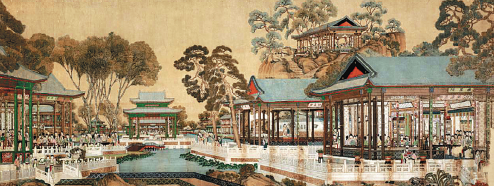
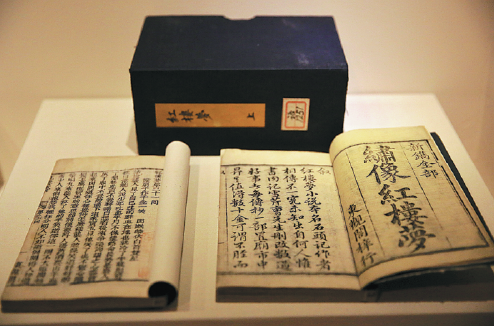
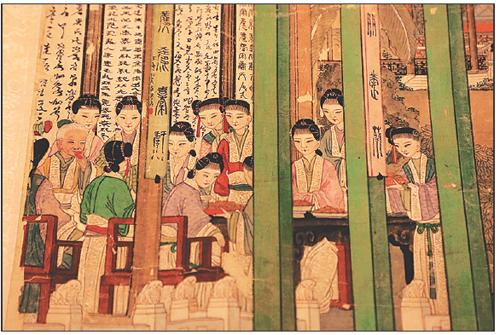
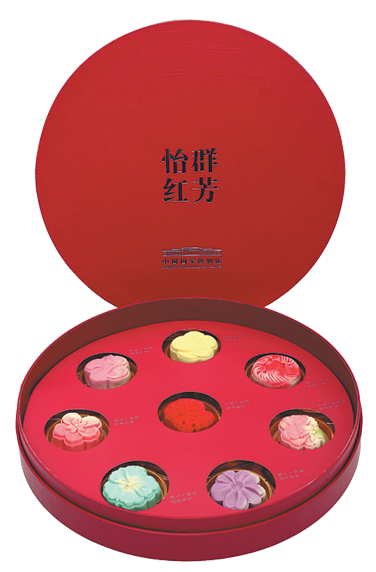
Today's Top News
- Unified national market a new growth launchpad
- US deal a structural challenge for Japan
- Industrial prowess of China a subject of serious study
- US new tariffs 'unfair': Experts
- NDRC recalibrating steps to drive growth, boost demand
- Wartime hero's legacy fortifies Sino-UK bond




















